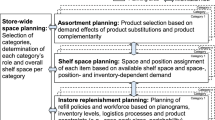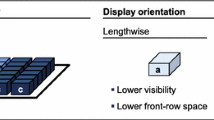Abstract
In the rapidly changing environment of Fast Moving Consumer Goods sector where new product launches are frequent, retail channels need to reallocate their shelf spaces intelligently while keeping up their total profit margins, and to simultaneously avoid product pollution. In this paper we propose an optimization model which yields the optimal product mix on the shelf in terms of profitability, and thus helps the retailers to use their shelves more effectively. The model is applied to the shampoo product class at two regional supermarket chains. The results reveal not only a computationally viable model, but also substantial potential increases in the profitability after the reorganization of the product list.
Similar content being viewed by others
References
Bai, R., & Kendall, G. (2005). An investigation of automated planograms using a simulated annealing based hyper-heuristics. In T. Ibaraki, K. Nonobe, & M. Yagiura (Eds.), Operations Research/Computer Science Interfaces Series : Vol. 32. Metaheuristics: Progress as Real Problem Solvers (pp. 87–108). Boston: Springer.
Bai, R., & Kendall, G. (2008). A model for fresh produce shelf space allocation and inventory management with freshness condition dependent demand. INFORMS Journal on Computing, 20(1), 78–85.
Bai, R., Burke, E. K., & Kendall, G. (2007). Heuristic, meta-heuristic and hyper-heuristic approaches for fresh produce inventory control and shelf space allocation. Journal of the Operational Research Society. doi:10.1057/palgrave.jors.2602463.
Borin, N., Farris, P. W., & Freeland, J. R. (1994). A model for determining retail product category assortment and shelf space allocation. Decision Sciences, 25(3), 359–384.
Cachon, G. P., Terwiesch, C., & Xu, Y. (2005). Retail assortment planning in the presence of consumer search. Manufacturing and Service Operations Management, 7(4), 330–346.
Corsten, D., & Gruen, T. (2003). Desperately seeking shelf availability: an examination of the extent, the causes, and the efforts to address retail out-of-stocks. International Journal of Retail and Distribution Management, 31, 605–617.
Corstjens, M., & Doyle, P. (1981). A model for optimizing retail space allocations. Management Science, 27, 822–833.
Kök, A. G., & Fisher, M. L. (2006). Demand estimation and assortment optimization under substitution: Methodology and application. Operations Research, 55, 1001–1021.
Kök, A. G., Fisher, M. L., & Vaidyanathan, R. (2006). Assortment planning: review of literature and industry practice. In N. Agrawal & S. Smith (Eds.), Retail supply chain management. Amsterdam: Kluwer.
Kurtuluş, M., & Toktay, L. B. (2005). Category captainship: who wins, who loses? Available at SSRN: http://ssrn.com/abstract=934970.
Mahajan, S., & van Ryzin, G. J. (1998). Retail inventories and consumer choice. In S. Tayur, et al. (Eds.), Quantitative methods in supply chain management. Amsterdam: Kluwer.
Mahajan, S., & van Ryzin, G. (2001). Stocking retail assortments under dynamic consumer substitution. Operations Research, 49, 334–351.
Netessine, S., & Rudi, N. (2003). Centralized and competitive inventory models with demand substitution. Operations Research, 51, 329–335.
Rajaram, K. (2001). Assortment planning in fashion retailing: methodology, planning and analysis. European Journal of Operational Research, 129, 186–208.
Schaible, S. (1977). A note on the sum of a linear and linear-fractional function. Naval Research Logistics Quarterly, 24, 691–693.
Smith, S. A., & Agrawal, N. (2000). Management of multi-item retail inventory systems with demand substitution. Operations Research, 48, 50–64.
Urban, T. L. (1998). An inventory-theoretic approach to product assortment and shelf space allocation. Journal of Retailing, 74, 15–35.
van Ryzin, G., & Mahajan, S. (1999). On the relationship between inventory costs and variety benefits in retail assortments. Management Science, 45, 1496–1509.
Yang, M.-H. (2001). An efficient algorithm to allocate shelf space. European Journal of Operational Research, 60, 309–317.
Yang, M.-H., & Chen, W. C. (1999). A study on shelf space allocation and management. International Journal of Production Economics, 60, 309–317.
Author information
Authors and Affiliations
Corresponding author
Additional information
The authors gratefully acknowledge the support from the Turkish Academy of Science.
Rights and permissions
About this article
Cite this article
Fadılog̃lu, M.M., Karaşan, O.E. & Pınar, M.Ç. A model and case study for efficient shelf usage and assortment analysis. Ann Oper Res 180, 105–124 (2010). https://doi.org/10.1007/s10479-008-0497-9
Published:
Issue Date:
DOI: https://doi.org/10.1007/s10479-008-0497-9




